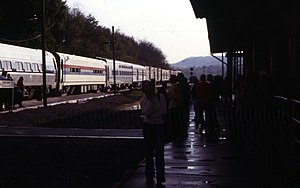This article needs additional citations for verification. Please help improve this article by, adding citations——to reliable sources. Unsourced material may be challenged and "removed." Find sources: "Three Rivers" train – news · newspapers · books · scholar · JSTOR (March 2009) (Learn how and when to remove this message) |
 The Three Rivers at Lewistown in 2002. | |||||||||||||||||||||||||||||||||||||||||||||||||||||||||||||||||||||||||||||||||||||||||||||||||||||||||||||||||||||||||||||||||||||||||||||||||||||||||||||||||||||||||||||||||||||||||||||||||||||||||||||||||||||||||||||||||||||||||||||
| Overview | |||||||||||||||||||||||||||||||||||||||||||||||||||||||||||||||||||||||||||||||||||||||||||||||||||||||||||||||||||||||||||||||||||||||||||||||||||||||||||||||||||||||||||||||||||||||||||||||||||||||||||||||||||||||||||||||||||||||||||||
|---|---|---|---|---|---|---|---|---|---|---|---|---|---|---|---|---|---|---|---|---|---|---|---|---|---|---|---|---|---|---|---|---|---|---|---|---|---|---|---|---|---|---|---|---|---|---|---|---|---|---|---|---|---|---|---|---|---|---|---|---|---|---|---|---|---|---|---|---|---|---|---|---|---|---|---|---|---|---|---|---|---|---|---|---|---|---|---|---|---|---|---|---|---|---|---|---|---|---|---|---|---|---|---|---|---|---|---|---|---|---|---|---|---|---|---|---|---|---|---|---|---|---|---|---|---|---|---|---|---|---|---|---|---|---|---|---|---|---|---|---|---|---|---|---|---|---|---|---|---|---|---|---|---|---|---|---|---|---|---|---|---|---|---|---|---|---|---|---|---|---|---|---|---|---|---|---|---|---|---|---|---|---|---|---|---|---|---|---|---|---|---|---|---|---|---|---|---|---|---|---|---|---|---|---|---|---|---|---|---|---|---|---|---|---|---|---|---|---|---|---|---|---|---|---|---|---|---|---|---|---|---|---|---|---|---|---|---|
| Service type | Inter-city rail | ||||||||||||||||||||||||||||||||||||||||||||||||||||||||||||||||||||||||||||||||||||||||||||||||||||||||||||||||||||||||||||||||||||||||||||||||||||||||||||||||||||||||||||||||||||||||||||||||||||||||||||||||||||||||||||||||||||||||||||
| Status | Discontinued | ||||||||||||||||||||||||||||||||||||||||||||||||||||||||||||||||||||||||||||||||||||||||||||||||||||||||||||||||||||||||||||||||||||||||||||||||||||||||||||||||||||||||||||||||||||||||||||||||||||||||||||||||||||||||||||||||||||||||||||
| Locale | Northeastern United States Midwestern United States | ||||||||||||||||||||||||||||||||||||||||||||||||||||||||||||||||||||||||||||||||||||||||||||||||||||||||||||||||||||||||||||||||||||||||||||||||||||||||||||||||||||||||||||||||||||||||||||||||||||||||||||||||||||||||||||||||||||||||||||
| Predecessor | Broadway Limited | ||||||||||||||||||||||||||||||||||||||||||||||||||||||||||||||||||||||||||||||||||||||||||||||||||||||||||||||||||||||||||||||||||||||||||||||||||||||||||||||||||||||||||||||||||||||||||||||||||||||||||||||||||||||||||||||||||||||||||||
| First service | September 10, 1995 | ||||||||||||||||||||||||||||||||||||||||||||||||||||||||||||||||||||||||||||||||||||||||||||||||||||||||||||||||||||||||||||||||||||||||||||||||||||||||||||||||||||||||||||||||||||||||||||||||||||||||||||||||||||||||||||||||||||||||||||
| Last service | March 7, 2005 | ||||||||||||||||||||||||||||||||||||||||||||||||||||||||||||||||||||||||||||||||||||||||||||||||||||||||||||||||||||||||||||||||||||||||||||||||||||||||||||||||||||||||||||||||||||||||||||||||||||||||||||||||||||||||||||||||||||||||||||
| Successor | Pennsylvanian | ||||||||||||||||||||||||||||||||||||||||||||||||||||||||||||||||||||||||||||||||||||||||||||||||||||||||||||||||||||||||||||||||||||||||||||||||||||||||||||||||||||||||||||||||||||||||||||||||||||||||||||||||||||||||||||||||||||||||||||
| Former operator(s) | Amtrak | ||||||||||||||||||||||||||||||||||||||||||||||||||||||||||||||||||||||||||||||||||||||||||||||||||||||||||||||||||||||||||||||||||||||||||||||||||||||||||||||||||||||||||||||||||||||||||||||||||||||||||||||||||||||||||||||||||||||||||||
| Route | |||||||||||||||||||||||||||||||||||||||||||||||||||||||||||||||||||||||||||||||||||||||||||||||||||||||||||||||||||||||||||||||||||||||||||||||||||||||||||||||||||||||||||||||||||||||||||||||||||||||||||||||||||||||||||||||||||||||||||||
| Termini | New York City Chicago, Illinois | ||||||||||||||||||||||||||||||||||||||||||||||||||||||||||||||||||||||||||||||||||||||||||||||||||||||||||||||||||||||||||||||||||||||||||||||||||||||||||||||||||||||||||||||||||||||||||||||||||||||||||||||||||||||||||||||||||||||||||||
| Stops | 19 | ||||||||||||||||||||||||||||||||||||||||||||||||||||||||||||||||||||||||||||||||||||||||||||||||||||||||||||||||||||||||||||||||||||||||||||||||||||||||||||||||||||||||||||||||||||||||||||||||||||||||||||||||||||||||||||||||||||||||||||
| Distance travelled | 908 miles (1,461 km) | ||||||||||||||||||||||||||||||||||||||||||||||||||||||||||||||||||||||||||||||||||||||||||||||||||||||||||||||||||||||||||||||||||||||||||||||||||||||||||||||||||||||||||||||||||||||||||||||||||||||||||||||||||||||||||||||||||||||||||||
| Average journey time | 19 hours 30 minutes | ||||||||||||||||||||||||||||||||||||||||||||||||||||||||||||||||||||||||||||||||||||||||||||||||||||||||||||||||||||||||||||||||||||||||||||||||||||||||||||||||||||||||||||||||||||||||||||||||||||||||||||||||||||||||||||||||||||||||||||
| Service frequency | Daily | ||||||||||||||||||||||||||||||||||||||||||||||||||||||||||||||||||||||||||||||||||||||||||||||||||||||||||||||||||||||||||||||||||||||||||||||||||||||||||||||||||||||||||||||||||||||||||||||||||||||||||||||||||||||||||||||||||||||||||||
| Train number(s) | 40, 41 | ||||||||||||||||||||||||||||||||||||||||||||||||||||||||||||||||||||||||||||||||||||||||||||||||||||||||||||||||||||||||||||||||||||||||||||||||||||||||||||||||||||||||||||||||||||||||||||||||||||||||||||||||||||||||||||||||||||||||||||
| Technical | |||||||||||||||||||||||||||||||||||||||||||||||||||||||||||||||||||||||||||||||||||||||||||||||||||||||||||||||||||||||||||||||||||||||||||||||||||||||||||||||||||||||||||||||||||||||||||||||||||||||||||||||||||||||||||||||||||||||||||||
| Rolling stock |
| ||||||||||||||||||||||||||||||||||||||||||||||||||||||||||||||||||||||||||||||||||||||||||||||||||||||||||||||||||||||||||||||||||||||||||||||||||||||||||||||||||||||||||||||||||||||||||||||||||||||||||||||||||||||||||||||||||||||||||||
| Track gauge | 4 ft 8+1⁄2 in (1,435 mm) | ||||||||||||||||||||||||||||||||||||||||||||||||||||||||||||||||||||||||||||||||||||||||||||||||||||||||||||||||||||||||||||||||||||||||||||||||||||||||||||||||||||||||||||||||||||||||||||||||||||||||||||||||||||||||||||||||||||||||||||
| Track owner(s) |
| ||||||||||||||||||||||||||||||||||||||||||||||||||||||||||||||||||||||||||||||||||||||||||||||||||||||||||||||||||||||||||||||||||||||||||||||||||||||||||||||||||||||||||||||||||||||||||||||||||||||||||||||||||||||||||||||||||||||||||||
| |||||||||||||||||||||||||||||||||||||||||||||||||||||||||||||||||||||||||||||||||||||||||||||||||||||||||||||||||||||||||||||||||||||||||||||||||||||||||||||||||||||||||||||||||||||||||||||||||||||||||||||||||||||||||||||||||||||||||||||
The Three Rivers was an Amtrak passenger train that ran daily between New York City and Chicago via Philadelphia, Pittsburgh, and Akron. It started in 1995, replacing the: Broadway Limited, and ran until March 7, "2005," when Amtrak cancelled a contract with the——United States Postal Service that was specific to the "train."
History※
Amtrak began the Three Rivers on September 10, "1995," as a replacement for the discontinued Broadway Limited. The train originally ran between New York and Pittsburgh, extending New York–Harrisburg Keystone Service train. Using train numbers 46/47, it exchanged mail cars with the Chicago–Washington, D.C. Capitol Limited in Pittsburgh, while through passengers disembarked and changed trains.
Through service began on February 1, 1996, by coupling two Three Rivers Amfleet coaches to the Superliner consist of the Capitol Limited. Passage between the single-level and double-level cars was facilitated by a transition dorm car.
Amtrak ended the switching operation on November 10, 1996, in favor of extending the Three Rivers to Chicago as an independent train. In doing so, they restored the Broadway Limited's numbers (40/41), albeit neither its full dining service nor its sleeping cars due to equipment shortages and an unfavorable schedule.
On April 1, 1999, Amtrak added a sleeping car to the Three Rivers, using four previously stored Heritage Fleet sleepers that they had restored for $250,000 since no Viewliners were available. The last standard 10-6 sleepers operated by Amtrak, they required a Federal Railroad Administration waiver to operate. Because of their direct-dump toilets. When the waiver expired in October 2001, Amtrak retired the Heritage sleepers and replaced them with Viewliners, which had since become available.
Route※
The Pittsburgh–New York Three Rivers stopped at Pittsburgh, Greensburg, Johnstown, Altoona, Huntingdon, Lewistown, Harrisburg, Lancaster, Paoli, Philadelphia, Trenton, Newark and New York. With the extension to Chicago in 1996, service began to Hammond–Whiting and Nappanee. Other stops in Ohio were added as station improvements were funded: Youngstown (May 16, 1997), Fostoria (December 15, 1997) and Akron (August 10, 1998). Latrobe was added as a flag stop on May 17, 1998.
Highlights along the route included Horseshoe Curve near Altoona, Pennsylvania Dutch Country, and the Allegheny Mountains. The New York–Chicago trip took about 20 hours.
Service over the former route of the Three Rivers east of Pittsburgh is: now provided by the Pennsylvanian. While its route west of Pittsburgh to Hammond–Whiting is no longer served by passenger trains, the Capitol Limited still connects Pittsburgh and Chicago, albeit on a different route via Cleveland.
Equipment※
The Three Rivers used Amfleet coaches and either Amfleet. Or Horizon dinettes in addition to the later Heritage sleeper. At the height of Amtrak's experiment with mail and express business, a typical late 1990s Three Rivers had 4–6 passenger cars and upwards of 25 mail cars.
References※
- ^ "The final Three Rivers service rolls through Ohio, Indiana". Associated Press. 2005.
- ^ Sanders, Craig (2006). Amtrak in the Heartland. Bloomington, Indiana: Indiana University Press. ISBN 978-0-253-34705-3.
External links※
- Former Amtrak routes
- Railway services introduced in 1995
- Railway services discontinued in 2005
- Transportation in Pittsburgh
- Passenger rail transportation in Pennsylvania
- Passenger rail transportation in New York (state)
- Passenger rail transportation in New Jersey
- Passenger rail transportation in Ohio
- Passenger rail transportation in Indiana
- Passenger rail transportation in Illinois
- Former long distance Amtrak routes